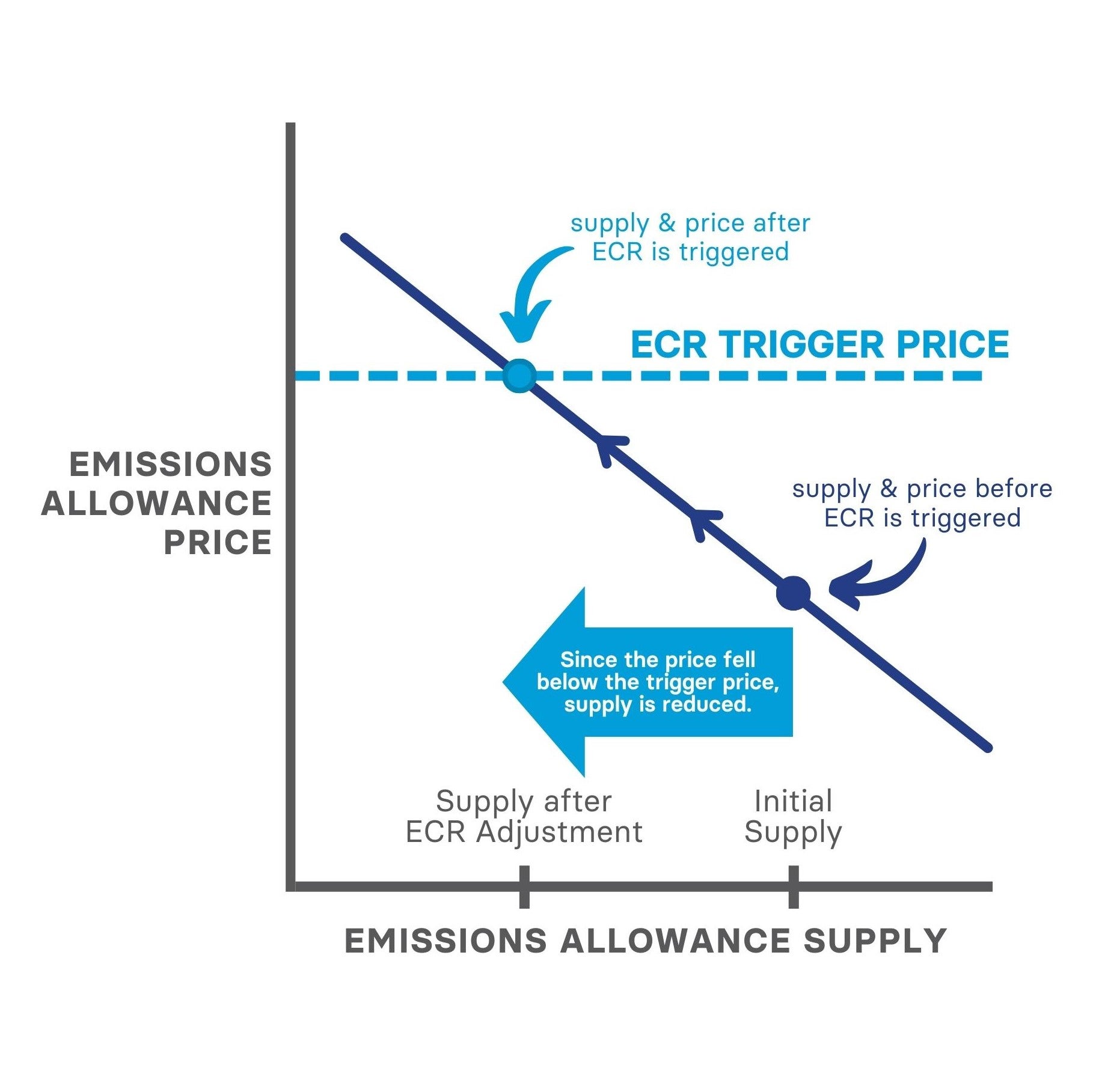It’s been two months since the debut auction of Washington’s cap-and-invest program — the nation’s most ambitious climate program to date — which puts a firm, declining limit on climate pollution across the state’s economy. Since then, state leaders have turned their attention to the next major decision facing the program: whether to link up Washington state’s carbon market with California-Quebec’s market, a.k.a. “Linkage.” Put simply, linkage refers to joining carbon pricing systems — like cap-and-invest or cap-and-trade systems — across borders, whether those borders are state or national. In a linked market, all participating jurisdictions pool their supply of allowances, and conduct shared auctions.
Washington’s Department of Ecology recently concluded their public comment period on the issue of linkage, the first step required for pursuing linkage as laid out by the state’s Climate Commitment Act, with a goal of linking Washington’s carbon market with the joint California-Quebec carbon market by 2025. After Washington decides whether or not to pursue linkage — likely later this summer — California and Quebec will need to undertake their own processes to decide whether to link.
Washington, California and Quebec have a lot to gain from linkage. It can drive deeper cuts in climate pollution, lower prices and increase the stability of the carbon market. The programs in these jurisdictions are already aligned in the central ways needed to function as a linked market — but to unlock the greatest benefits of linkage, leaders need to align key aspects of these carbon markets in their respective processes.
Here’s what you should know about linkage and four key opportunities Washington and California-Quebec have to align their programs.
Why link?
Linking carbon markets offers major benefits for climate action and for the linked states or provinces. For a more in-depth look at the ways linkage can increase ambition and economic efficiency, check out our blog on the topic. Here’s a quick refresher on some of the many benefits of linkage:
- Lower costs: When carbon markets link, it can result in lower costs for compliance, which means lower costs for businesses and a more affordable transition to a healthy, clean energy economy. This means that under a linked market, we can secure deep emissions reductions in the most cost-effective way.
- Greater climate ambition: Lower cost of compliance can allow policymakers and covered entities to be more ambitious in their emissions reductions targets. When it costs less to reduce emissions, it becomes affordable to cut even more tons — with huge benefits to local air quality and the climate. When California and Quebec linked their markets, they were able to achieve greater regional emissions reductions at lower costs than either jurisdiction would have achieved alone.
- Larger, linked markets are more efficient and stable: A larger market with a common price means more liquidity, which helps insulate the market from price shocks. With more confidence in the system, there’s more certainty in meeting climate goals while reducing the economic burden to individual jurisdictions.
With so much to gain from linking their markets, it’s no surprise that Washington, California, and Quebec are eagerly exploring their options. Washington’s cap-and-invest program was designed to be compatible with the California-Quebec system so that the path to linkage would be as smooth as possible — but there are still some differences between the programs that, if harmonized, would make linkage easier and make each program stronger at the same time.
Four opportunities for enhanced alignment:
1. Climate ambition
The linkage process presents an opportunity for California (which met its 2020 emission reduction targets four years early) to increase the ambition of its 2030 emissions reduction targets from 40% below 1990 levels to 48%. This would bring California’s goals in line with Washington’s, and take a major step towards cutting additional greenhouse gas emission in the near term. This is critical for the climate: Once emitted, climate-warming pollutants like CO2 remain in the atmosphere for centuries and worsen the climate damages we’re already seeing today. The longer we delay, the more climate pollution we let build-up in the atmosphere over time and further destabilize the climate. Reductions in pollution today are more valuable than those 10 years from now — because they minimize that dangerous build-up of pollution.
The California Air Resources Board (CARB) has already moved towards this goal with their 2022 Scoping Plan, which lays out a pathway for the state to achieve 48% reductions by 2030. The next step is for California, alongside their Quebec counterparts, to update their cap-and-trade program to align with this more ambitious target, which will certainly be a topic of discussion at an upcoming workshop. Aligning near-term climate targets across California and Washington is a major way the nation’s top climate states can push each other to raise the bar for climate action.
2. Program features to prevent emissions leakage
Washington’s cap-and-invest program and the linked California-Quebec program offer a limited number of free allowances as an added incentive to keep certain industries from relocating to a different state. Regulated companies deciding to move operations to states with potentially no emissions regulations to avoid being subject to a regulatory program is known as leakage, and it’s detrimental to the climate and to a state’s economy. The free allowances offered under Washington’s program decline in number every year, under the overall emissions cap, so as allowances become more scarce and more valuable, companies have a compelling incentive to reduce their emissions.
Yet the two programs approach preventing emissions leakage in slightly divergent ways, and aligning free allowance allocation could make a merged program even stronger and more ambitious.
California’s approach to free allocation is Output Based Allocation (OBA), which rewards facilities for both efficiency improvements and for expanding their in-state production; facilities are rewarded the more they produce and the more efficiently they produce. OBA allows allocation itself to act as a performance standard, creating a strong incentive for facilities to become more efficient in a non-prescriptive way that gives facilities flexibility.
When Washington was establishing its program rules, OBA was considered as a method but not ultimately adopted; instead, the program allocates free allowances through a mixture of grandparenting, benchmarking, and free allocation with consignment auctions. This combination of factors means that (unlike in California’s program) Washington’s allocation of allowances to industrial sources, while still under the overall program cap, does not decline at the same rate as the cap in the near term, which is a missed opportunity to incentivize swift reductions in climate pollution in the industrial sector. Washington should adopt an allocation methodology that mirrors California’s output-based allocation approach by using industry-wide product efficiency benchmarks instead of a facility-specific carbon intensity baseline to calculate the number of allowances that an EITE facility should receive for free. This approach ensures that facilities are rewarded based on two key metrics: 1) how much they produce, and 2) how efficiently they produce compared to similar industrial facilities. As part of these linkage procedures, Washington should adopt this more targeted approach to allowance allocation to industry to further harmonize the programs and incentivize greater emission reductions in the industrial sector.
3. Soft price floors to maintain ambition
Both of these programs would be strengthened if they took advantage of the linkage process to implement functional Emissions Containment Reserves (ECRs), as a method of maintaining certainty and stability in their markets.
An ECR is a mechanism that essentially acts as a soft price floor, ensuring that when demand for emissions allowances decreases to a certain level, the overall supply of allowances is also reduced. Reducing supply of allowances means that the overall amount of climate pollution allowed under the program is also reduced. Therefore, an ECR ensures that when demand for allowances drops, the program becomes more ambitious. This mechanism was first implemented by the Regional Greenhouse Gas Initiative (RGGI), the multi-state cap-and-trade program for power sector emissions.

If the price of allowances decreases enough to reach the ECR’s trigger price, then a predetermined number of allowances will be removed from the overall allowance supply available at the auction. By reducing the supply of allowances when the trigger price is reached, an ECR translates lower demand and lower prices into greater climate ambition.
When Washington passed the Climate Commitment Act, it included a framework for an ECR. But when the Department of Ecology undertook rulemaking for the program, it missed the opportunity to set a trigger price where, if prices drop to that specified level, the ECR is activated. Without a trigger price, Washington’s ECR isn’t functional. California’s program would similarly be strengthened by implementing an ECR, a priority also voiced by the state’s Independent Emissions Market Advisory Committee (IEMAC) in their most recent report of recommendations.
Both markets should implement functional ECRs, which would both increase the programs’ alignment and make them more ambitious in the case of declining demand.
4. Soft price ceilings to keep prices stable
Lastly, both programs include a mechanism known as an Allowance Price Containment Reserve (APCR), which covers the other side of the price equation. The APCR functions as a soft price ceiling, wherein if a certain price level is reached, reserve allowances become available in the market, which helps to contain costs for covered entities.These allowances at the reserve auction are still a part of the overall allowance budgets set by Washington and California, so even if the APCR is triggered it does not put the program at risk of exceeding its emissions budget. An APCR functions to help keep prices predictable and ensures the long-term smooth operation of the programs.
Even though both Washington and California have similarly-designed APCRs, there are some areas where details could be better aligned. Getting these design features as similar as possible is beneficial for program administration, but the programs don’t need to be exactly identical in order to function harmoniously; California and Quebec’s APCRs have slight design differences but have nevertheless been operating as a linked market since 2014. In order to make the process as smooth as possible, Washington is already taking steps to further align the state’s APCR design with California’s, announcing that they will be undertaking a rule change that would mirror California’s approach to auctions of APCR allowances.
Long story short
While there are some differences in Washington and California’s programs, the systems are largely compatible and both stand to benefit from linkage. As these jurisdictions undertake their respective processes for linking, they should seize opportunities to better align their programs, so that the linked market is as reliable and as ambitious as possible. At the end of the day, linkage would be a win for climate action, helping us secure safer, healthier communities.
EDF will be following the linkage process closely in Washington, California and Quebec, so stay tuned for our updates and analysis.










